in. - Abbreviation for inch.
inanimate - Neither moving nor having other qualities associated with living organisms.
inch - A unit of distance measurement equal to 1/12 of a foot, or 1/36 of a yard. To convert inches into centimeters, multiply them by 2.54. To convert square inches into square centimeters, multiply them by 6.4516. To convert cubic inches into cubic centimeters, multiply them by 16.3871. A unit of measurement equal to a thousandth of an inch is a mil. Inch is abbreviated in. or with a " (feet is abbreviated as ft. or with a ').
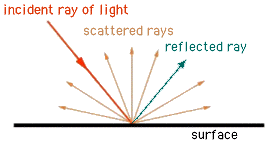 incident
light - The light hitting an object's surface,
not that reflected or scattered
from it. The wavelength of incident
light is usually more varied than that reflected from a surface,
determining the colors perceived
in the object. It undergoes selective absorption
of some wavelengths as it is reflected. The law of reflection
is a principle that when light is reflected from a smooth surface,
the angle of incidence — the angle at which the light
hits a surface — is equal to the angle of reflection, and the
incident ray, the reflected
ray, and the normal to the surface all lie in the same plane.
incident
light - The light hitting an object's surface,
not that reflected or scattered
from it. The wavelength of incident
light is usually more varied than that reflected from a surface,
determining the colors perceived
in the object. It undergoes selective absorption
of some wavelengths as it is reflected. The law of reflection
is a principle that when light is reflected from a smooth surface,
the angle of incidence — the angle at which the light
hits a surface — is equal to the angle of reflection, and the
incident ray, the reflected
ray, and the normal to the surface all lie in the same plane.
Also see additive, mirror, optical mixing, primary colors, and subtractive.
incising - Cutting into a surface, typically in metal, stone, or pottery, often used for lettering and decoration. An example is a Tablet which has an incised glyphic inscription, Mexico: state of Guerrero, Ahuelican, Highland Olmec, Middle Formative period, 900-500 BCE, greenstone, 3 1/2 x 3 1/2 x 3/4 inches, Dallas Museum of Art.
(pr. in-SI:-zəng)
Other examples:
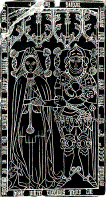
English (Barlow, Derbyshire), Memorial to Robert and Margaret Barley,
1467, incised brass plaque,
represented by a rubbing (frottage).
Robert Barley is wearing the Yorkist collar of suns and roses
is shown, attesting the deceased's connections with the Yorkist
royal line. See costume
and memorial.

Peter McLennan (English, contemporary), Plaque marking the site in 1994 of the ordaining
of the first women as priests in England, Bristol Cathedral,
incised and carved relief. Peter McLennan is a letter
cutter and sculptor, who
works in wood, slate, and
stone. See commemorate
and monument.
Also see encaustic, engraving, ostracon, text, and wood.
incoherence, incoherent - The opposite of coherence, coherent.
incongruity - A state of two or more things lacking harmony, being incompatible, inconsistent, absurdly combined. Such things would be described as incongruous. This sometimes results in irony. What makes something humorous or tragic is essentially an instance of incongruity. Incongruity is an idea explored often by artists influenced by Dada and Surrealism.
(pr. IN-kahn-GROO-ə-tee)
Examples:
René Magritte (Belgian, 1898-1967), The Treachery [or Treason] of Images, 1928-9, oil on canvas, 23 1/4 x 31 1/2 inches, private collection, NY. "Ceci n'est pas une pipe," means "This is not a pipe." See Surrealism.
René Magritte, The Rape, 1934, oil on canvas.
René Magritte, The Age of Enlightenment, oil on canvas.
René Magritte, Euclidean Promenades, 1955, oil on canvas, 64 x 51 1/2 inches, Minneapolis Institute of Arts.
René Magritte, La clef de verre, 1959, Menil Collection.
Salvador Dalí (Spanish, 1904-1989), Lobster Telephone, 1936, plastic, painted plaster and mixed media, 17.8 x 33.0 x 17.8 cm, Tate Gallery, London. This sculpture is a classic example of the Surrealist practice of juxtaposing otherwise unrelated everyday items. The Surrealists valued the mysterious and provocative effect of such incongruities. Dalí believed that his objects expressed the secret desires of the unconscious, and that lobsters and telephones reveal the prominence of the sexuality.
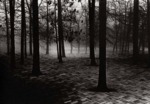
Scott Mutter (American, 1944-), Untitled (Forest), 1975, gelatine-silver
print photomontage, 11 x
14 inches, American
Museum of Photography. This forest has a parquet
floor. "While others use the techniques of photomontage
for shock effect, Mutter creates worlds that can best be described
as 'hyper-realistic.' "
Also see absurd, advertising, amphibolous, angst, anomaly, compare, consistency, counterpoint, cryptic, detournement, emphasis, exquisite corpse, Fluxus, focal point, frisson, grotesque, interesting, juxtaposition, pain, reversible, Rube Goldberg, and Surrealism.
inconsistency - See consistency.
incrassate - To make a liquid thicker, or to allow a liquid to become thicker; to thicken; inspissate.
(pr. in-KRASS-ayt)
Also see soluble, solve, solvent, vehicle, viscosity, waterproof, and water-soluble.
incrustation - Also called "masonry," incrustation
is a style of classical
Roman wall decoration in which the wall was
divided into bright, polychrome
panels of solid colors
with occasional, schematically rendered
textural contrasts,
often veined in imitation of polished
slabs of marble
(see marbling).  Of
the few Roman paintings that survive,
most are frescoes from
the area of Campania in the vicinity of Naples, including Pompeii,
Herculaneum, and other towns whose people, art and architecture were destroyed and preserved
for us by the eruption of Mount Vesuvius in 79 CE.
Domestic interiors were windowless and dark, giving Romans a need
to visually enliven them. First produced in the 3rd century BCE,
incrustation was the earliest of four styles of Roman wall paintings
which have been identified.
Of
the few Roman paintings that survive,
most are frescoes from
the area of Campania in the vicinity of Naples, including Pompeii,
Herculaneum, and other towns whose people, art and architecture were destroyed and preserved
for us by the eruption of Mount Vesuvius in 79 CE.
Domestic interiors were windowless and dark, giving Romans a need
to visually enliven them. First produced in the 3rd century BCE,
incrustation was the earliest of four styles of Roman wall paintings
which have been identified.
Example:

Roman, ![]()
 Wall
in the House of Sallust, Pompeii, 3rd century BCE, fresco,
in situ.
Wall
in the House of Sallust, Pompeii, 3rd century BCE, fresco,
in situ.
A
reconstruction of how it may have originally looked and
The second style — "architectonic" — from early in the 1st century BCE, included the use of linear perspective, creating the illusion of windows looking onto scenic landscapes. The third style — "ornamental" — first employed during Augustan's rule at the end of the 1st century BCE, flattened the wall again with sets of pictures as in a gallery, some effecting trompe l'oeil. The fourth style is a composite of the earlier three, in use during the 1st and 2nd centuries CE.
Related link:
incubation - The name used first by Jacob Getzel (American psychologist) for the third stage in the creative process: mulling over the problem in a sort of chaos of ideas and knowledge, letting go of certainties (forgetting); engaging the intuitive, non-sequential, or global thinking at the core of creativity. This is what some call "breathing room" or "downtime." Although we appear to be most productive when we actively pursue our goals, and a sense of urgency can be as speeding as a healthy eagerness, the most creative amongst us must prepare for this stage of work by giving our imaginations time to dwell upon a situation, indirectly as well as directly, dreaming about it in a seemingly idle way. Beware of attempts to remove such incubation periods from any schedule of creative pursuits.
Also see memory.
index - A recording of an event produced by a connection between an object and its role in the event. In semiotics, as presented by Charles Sanders Peirce (American pragmatist, 1839-1914; pr. purse), there are three kinds of signs: icon, index and symbol. Whether a sign belongs in one category or another is dependent upon the nature of its relationship between the sign itself (which Peirce called the referent) and its the actual meaning. An icon is a meaning which is based upon similarity or appearance (for example, similarity in shape). According to Pierce, icons are "the only means of directly communicating an idea." An index is a meaning based upon some cause and effect relationship: "Because the indexical sign is understood to be connected to the real object, it is capable of making that object conceptually present."
The plural form of this word is indices. The adjectival form is indexical.
Examples of indices:
![]()
![]()
![]()
Thermometers carry a certain meaning because of variation in temperature.

Footprints carry certain meaning because of their associations with specific creatures.
One reason Action Painting was significant was its practitioners' assertion that its indexical nature — the painter's brushstrokes as expressive of his/her activity.
Examples of Action Painting:
![]()
Franz Kline (American, 1910-1962), Merce C, 1961, National Museum of American Art, Washington, DC.
Jackson Pollock (American, 1912-1956), Autumn Rhythm (#30), 1950, oil on canvas, 105 x 207 inches (266.7 x 525.8 cm), Metropolitan Museum of Art, NY.

Jackson Pollock, One: Number 31, 1950, 1950, oil and enamel on unprimed canvas, 8 feet 10 inches x 17 feet 5 5/8 inches (269.5 x 530.8 cm).
Index of American Design - A New Deal
art program that hired numerous artists to produce more than
18,000 watercolor
renderings of American decorative arts objects
from the colonial period
![]()
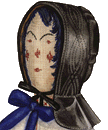 through the nineteenth
century, including costumes, dolls, folk arts of the Spanish Southwest, furniture, metalwork, Pennsylvania German folk art, pottery, Shaker crafts, textiles, toys, and woodcarving. The Index of American Design
was one of the projects between 1935 and 1942 of the Section
of Painting and Sculpture (SPS), later known as the Section
of Fine Arts (SFA) in the Treasury Department of the U.S. government.
Much
or all of the Index is now in the collection of the National Gallery
of Art, Washington, DC. Tours of the Index of American Design
are available as slide programs from the National Gallery's Department
of Education Resources: Free Loan Programs.
through the nineteenth
century, including costumes, dolls, folk arts of the Spanish Southwest, furniture, metalwork, Pennsylvania German folk art, pottery, Shaker crafts, textiles, toys, and woodcarving. The Index of American Design
was one of the projects between 1935 and 1942 of the Section
of Painting and Sculpture (SPS), later known as the Section
of Fine Arts (SFA) in the Treasury Department of the U.S. government.
Much
or all of the Index is now in the collection of the National Gallery
of Art, Washington, DC. Tours of the Index of American Design
are available as slide programs from the National Gallery's Department
of Education Resources: Free Loan Programs.
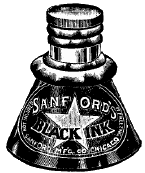
India ink or Indian ink - The name in the United States for black ink, the pigment made from carbon — traditionally lampblack (derived from non-electric lamps). This ink is also used in solid forms, mixed with a binding agent and molded into cakes or sticks. Such solid forms are often called Chinese ink, Japanese ink, or sumi ink.
A related link:
Also see acrylic paints, autographic ink, bistre, black, body color, Chinese art, gouache, heighten, iron-gall ink, Japanese art, nib, oil paint, pen, quill pen, reed pen, sepia ink, wash, watercolor, and zinc white.
Indian art (art of India) - See Hindu art and Hinduism and Buddhist art and Buddhism.
Indian art (art of Native Americans)
Indian yellow - A particular yellow pigment.
Related resource:
indigo - A particular blue pigment.
Related resource:
indirect carving - A carving technique in which a sculpture is made by copying the proportions of a small scale model.
Also see pointing.
indirect casting - Lost-wax metal casting in which the model that is "lost" is not the original model, but a wax cast from a piece mold taken from the original model. This second wax model is sometimes called an indirect casting, or an intermodel. If the indirect casting is hollow, a core is pored into it. The ancient Greeks developed this method of casting.
Indirect casting has numerous advantages because it:
Indirect casting was rediscovered during the Renaissance.
Individualized Education Program (IEP) - An educational prescription, designed by educators and students' families, recommending services and programs to meet students' special needs.
Also see achievement, effort, tactile defensiveness, and VSA arts.
inert - Stable, unable to move or act at all, or sluggish in motion. In chemistry, not readily reactive with other elements; thus forming few compounds. Inert substances and materials are not easily decomposed or otherwise modified chemically, which is a particularly desirable characteristic for materials used in art conservation. Acid free papers and cardboards, for example, are more inert than acidic ones, so they degrade much more slowly; they are less likely to become discolored and brittle over time or upon exposure to various conditions during use or storage.
Also see hypoactive.
inflatable - A sculpture or other object made with a plastic or PVC film or fabric which achieves its intended form when filled with air or some other gas.
Examples:
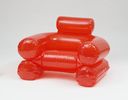
Paolo Lomazzi, Donato D'Urbino and Jonathan De Pas, manufactured by Zanotta S.p.A., Italy, Blow Inflatable Armchair, 1967, polyvinyl chloride (PVC) plastic, inflated: 33 x 47 1/8 x 40 1/4 inches (83.8 x 119.7 x 102.9 cm), Museum of Modern Art, NY. See furniture.

![]()

Jeffrey Shaw (Australian, 1944-), with Theo
Botschuijver (Dutch), Waterwalk, 1969, air structure
event, tetrahedron shaped balloon
made from transparent (and
sometimes colored)
plastic, height 3 m. A watertight
zipper allowed people to enter and be sealed inside. When this
lightweight structure was inflated with air, one or more people
could "walk on water" by stepping and rotating it like
a wheel over the water surface.
The large volume of air in
the balloon allowed the occupants some time for their journeys
— and whenever they wished they could simply unzip themselves
out. Lakes, rivers and the sea were the venues of what the artist
calls an "eventstructure." See Happening and performance art.

Jon Goldman (American, contemporary), In a Lamprey's Mouth, 1986, inflatable
sculpture, computer-controlled interactive sound, nylon,
blower.

Cara Perlman (American, contemporary), Mother's Breath, 1997, on Wooster Street, between Grand and Canal, NYC. Deitch Gallery said, "Looming overhead, this giant balloon comes as a delightful surprise: a humorous yet slightly sinister gesture. Glowing from inside at night, the installation is in conjunction with the Downtown Arts Festival."
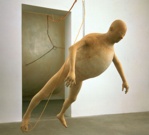
Tim Hawkinson (American, 1960-), Balloon Self-Portrait, 2004?, latex sculpture, life size cast from the artist's body, turned inside out, then inflated by an air compressor, Ace Gallery, NYC. See self-portrait.



Cesar Martinez (Mexican, Mexico City, 1962-),
Aqui
estoy, 2001, inflatable latex
sculpture, life size.
Related  link:
link:
infrared - is coming soon
infrared reflectography (IR) and reflectogram - Infrared reflectography (IR) is used to examine the surface of the ground layer of any painting, even when it is covered by one or many layers of paint. The result of the IR technique is a black and white photograph called a reflectogram. Such images permit art historians to read the underdrawings beneath the paint. This is possible because light in the near-infrared region of the spectrum (wavelengths from about 1 up to 2 microns) easily passes through the paint, to be reflected by the marks used to make the underdrawing. Reflectograms allow a researcher to obtain information about the painter's drawing media and techniques, and even to find and read hidden writings. These might include signatures and dates sometimes covered by earlier restorations. Reflectograms occasionally reveal artists' earlier versions of their compositions (pentimenti), and even sketches of things not visible in the painting as it is seen today. Reflectography is often used by restorers and conservators. In many cases it improves analysis of the creative development of the artwork and reveals pieces of previous restorations. Reflectograms were first made in the early 1930s, when the technique was called "IR photography." Various improvements to IR since then have led to a digital version of the technique — an infrared scanner is connected to a high-powered computer. This advance has made possible far more useful images than ever before, because more gradations of value are now achieveable.
Example:

![]()
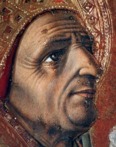
Matteo di Giovanni (Italian), detail of The
Virgin with Child and Saints, in color and in the IR reflectogram. This painting was
executed for the Cathedral of Pienza.
Also see art conservation, radiograph, and x-ray.
initial letter - See capital letters and historiated.
inkblot or ink blot - An image
formed by dripping ink onto a 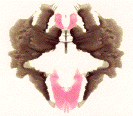 piece of paper,
piece of paper,
 and then folding the paper in half. Inkblots
are invariably symmetrical,
but making them is largely aleatoric,
their shapes depending greatly
upon accident or chance. Painted
versions of inkblots are called blotto
painting. In psychology, inkblots have been used in the Rohrschach test (
and then folding the paper in half. Inkblots
are invariably symmetrical,
but making them is largely aleatoric,
their shapes depending greatly
upon accident or chance. Painted
versions of inkblots are called blotto
painting. In psychology, inkblots have been used in the Rohrschach test (an example). Also see blot.
inlay - Making an image by setting thin pieces of a material precisely into a depressed ground. Examples of materials typically inlaid are wood, metal, stone, shell, glass, ivory and tile. Also, a piece of work made this way.
Examples:
![]()
Greek,
late fourth century BCE,
Statue of a Victorious Youth, bronze
with copper inlays, height
59 5/8 inches (151.5 cm), J. Paul Getty Museum, Malibu, CA. See Greek art.
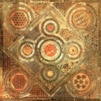
The Cosmati Pavement, the floor in front
of the High Altar of Westminster Abbey, London, colored marbles inlaid into a ground
of plain marble. This style of marble
pavement is called "Cosmati work" after the Italian
family that developed the technique
of producing it. Westminster Abbey dates from the 13th-16th centuries.
See altar and intarsia.
Herter Brothers, United States, New York, 1865-1905, Moorish Cabinet, c 1880, rosewood, other exotic woods, glass, mother-of-pearl, and velvet, 80 x 36 x 24 inches (203.2 x 91.4 x 61 cm), Los Angeles County Museum of Art. See furniture.
Also see intarsia, labyrinth, marquetry, mosaic, niello, and parquetry.
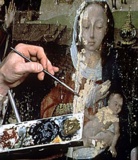
inpaint - In art restoration, to repaint a damaged or missing portion of a painting in order to return the artwork to visual harmony. There may be other treatments necessary in a painting's restoration which should precede the point at which inpainting is appropriate. Preparatory stages might include stabilizing the support and its surface, and filling areas of lost paint to raise the depth of any gap between the support and the surface of surrounding paint. This filling material may need to be textured to match the original paint surrounding it. It may also be necessary to apply several layers of color in order to precisely match the surrounding paint. Inpainting should be carried out with conservationally sound materials, easily reversible and distinguishable from the original. In order to detect inpainting in an old painting, carefully examine it under both white and ultraviolet (UV) light. Although the value of old and new colors may be identical under white light, because recently applied paint absorbs UV, infills will appear to be darker than otherwise matching original paint. See art conservation and lacuna.
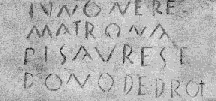
inscribe and inscription - To mark as with letters or numbers, often a short label, as an artist might formally mark his name, a title, the year, a dedication, etc. Such a label can be called an inscription.
Examples:
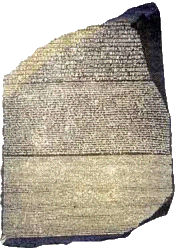
Egypt, 203 BCE,
Rosetta
Stone, a slab of granite,
3 feet 9 inches x 2 feet 4 inches wide x 11 inches thick (118
x 77cm), the remains of a stele
inscribed in three scripts: hieroglyphic, later Egyptian demotic
— a cursive form of ancient Egyptian, and ancient Greek. Each
of these three scripts were being used in Egypt at the time it
was carved. An officer of Napoleon's engineering corps found
the stone half buried in the mud near Rosetta, a city near Alexandria,
in 1799. Carved on the stone is a decree by Egyptian
priests to commemorate the
crowning of Ptolemy V Epiphanes, king of Egypt from 203 - 181
BCE
The Stone is an icon of script
and decipherment.
North Africa (Tunisia, Byzacena, Roman, c. 300 CE), Dedicatory Inscription (in Latin), marble, 17 1/2 x 32 inches (44.5 x 81.3 cm), Michael C. Carlos Museum, Emery U, Atlanta, GA. See capital.
Vecchietta (Lorenzo di Piero di Giovanni) (Italian, 1410-1480), The Resurrection, 1472, bronze, height 21 3/8 inches (54.3 cm), width 16 1/4 inches (41.2 cm), Frick Collection, NY. Inscribed on the center panel of the sarcophagus: OPUS.LAUR / ENTII.PETRI.P / ITTORIS.AL / VECHIETTA. / DE ENIS.M. / CCCC.LXXII
Francesco Laurana (Italian, c.1430-c.1502), Beatrice of Aragon, probably 1470s, marble bust, height 16 inches (40.6 cm), width 15 7/8 inches (40.4 cm), diameter 7 7/8 inches (20 cm), Frick Collection, NY. Inscribed: DIVA BEATRIX ARAGONIA
Jacques Jonghelinck (Flemish, 1530-1606), The Duke of Alba, 1571, bronze bust, height 45 7/8 inches (116.5 cm), Frick Collection, NY. Inscribed on the curved face of the base: FERDINAND, / ALBAE / DVX; and, on the lowest riser: IVNGELLINGUS OPTIMO DVCI / 1571

Eric Gill (English, 1882-1940), Inscription 'Ex Divina Pulchritudine',
1926, Hoptonwood stone relief, 30.6 x
45.7 x 3.8 cm, Tate Gallery, London. This Latin inscription is
an aphorism meaning, "The
beauty of God is the cause of the being of all that is."
Also see colophon.
insensitivity - The opposite of sensitivity.
in situ - In place; in the original position.
(pr. in si:'too)
Also see living rock and public art.
insouciance - Breezy lack of concern; nonchalance.
inspiration - Somebody or something that stimulates a person to a high level of feeling, to creative thought, or to achieve the making of art. Inspiration may be the condition or quality of being stimulated to creative thought or activity. A sudden brilliant idea. To those who are religious, inspiration may be divine guidance and influence on human beings. To inspire someone is to fill that person with confidence and motivation; an inspired person feels that he or she can achieve something difficult or special.
(IN-spə-RAY-shən)
Quotations:

Also see attitude, effort, memory, mind, muses, quotations, success, talent, and virtuosity.
insula - In Roman architecture, a multistoried apartment block.
intaglio - The collective term for several graphic processes in which prints are made from ink trapped in the grooves in an incised metal plate. Etchings and engravings are the most typical examples. It may also refer to imagery incised on gems or hardstones, seals, and dies for coins, or to an object decorated in this way; which when pressed or stamped into a soft substance, produces a positive relief in that substance.
(pr. in-TAHL-yo)
An example of an intaglio in the second sense:

Dexamenos (Greek, Chios), Intaglio of a Flying Heron, 5th century
BCE,
chalcedony, gold,
1.7 x 2.2 cm, State Hermitage Museum, St. Petersburg, Russia.
Also see glyptic and numismatics.
intarsia - Inlay work, primarily in wood and sometimes in mother-of-pearl, ivory, bone, marble, etc. This may result in either pattern or picture. To construct intarsia, outline drawings are used as templates for cutting many pieces of thin material. The cut pieces are glued onto a sturdy support. In a wooden intarsia, many types of wood provide the different colors used. Sometimes stains, bleaches, or heat were applied to the wood to provide a wider range of tints, tones, and shades. The English word "intarsia" came from the Italian "lavoro di intarsia."
(pr. in-TAHR-see-ə)
Examples:

Fra Giovanni da Verona (Italian), Intarsia Illusion of Cupboards, two pairs of panels of wood intarsia, 1520: Each conveys the appearance of open cupboard doors — a trompe l'oeil effect resulting from the use of linear perspective. The first panel: a Campanus sphere, a mazzocchio, and various instruments of the geometer.
The second panel: a complex polyhedron which can be constructed by erecting a pyramid of equilateral triangles on each face of an icosidodecahedron. These first two panels are in the Monastery of Monte Olivetto Maggiore, near Siena, Italy.
The third: the Campanus sphere again, along with an icosahedron and a truncated icosahedron.
The fourth: a cube with equilateral pyramids erected on each face, a cuboctahedron, and again the elevated icosidodecahedron. The second two panels are in the church of Santa Maria in Organo, Verona.
![]()

![]()
Contemporary stone intarsia, marble and other stones, 36 x 36 inches.
Also see labyrinth, marquetry, mosaic, and veneer.
intensity - The brightness or dullness of a hue or color. For instance, the intensity of the pure color blue is very bright. When a lighter or darker color is added to blue, the intensity is less bright, or more subdued.
Also see saturation, shade, tint, tone, and value.
intercolumniation - In architecture, the space or the system of spacing between columns in a colonnade.
interdisciplinary - Involving two or more artistic, scientific, or other academic disciplines. While exploring a concept, issue, or theme, interdisciplinary studies adopt methods and theories from different fields of study, often within an academic context. Artists have produced numerous interdisciplinary works since the early 20th century, and more so since the onset of postmodernism. Emblematic of this trend has been the breakdown of boundaries between such categories in art as painting and sculpture, between painting and theater, between drawing and cinema. Examples of interdisciplinary synthesis can be found among combine paintings, works by Fluxus artists, conceptual art, earth art, environment art, and performance art, among many others. New media is perhaps the latest such example. The visual arts have many traditional interdisciplinary connections with mathematics and the sciences, architecture, design, music, philosophy (empiricism, epistemology, metaphysics, ontology, phenomenology, semiotics, teleology, etc.), history, archaeology, anthropology, ethnology, psychology, technology, manufacturing, and many other fields.
Concepts having interdisciplinary aspects include abstraction, analogy, cartography, chronology, civilization, culture, elegance, entropy, ergonomics, feminism, horology, kinesthetic, knowledge, measurement, metallurgy, metamorphosis, mind, model, mystery, ophthalmology, optics, order, pattern, periodicity, photography, simplicity, space-time, structure, transformation, typology, and unity.
Also see advertising, art careers, art therapy, Bloom's Taxonomy, bone structure, dance, mass media, mixed media, multimedia, multiple intelligence theory, and multisensory.
interior design - The planning and realization of the layout, furnishing and decoration of an architectural interior. Sometimes called interior decoration, but preferred to that term, because of decoration's more superficial goals.
Also see design and furniture.
intermedia - See mixed media or mixed-media.
intermediate colors - Also known as tertiary color, they are produced by mixing unequal amounts of two primary colors. For example, adding more red to the combination of red and yellow will produce the intermediate color of red-orange. Intermediate colors are located between the primary and secondary colors on a color wheel. Other intermediate colors are orange-yellow, yellow-green, green-blue, blue-violet, and violet-red (also known as purple) — all colors in the spectrum except violet-red — a mixture of the two colors at the extremes of the visible spectrum.
intermodel - See indirect casting.

International Council of Museums (ICOM) - An international organisation of museums and museum professionals which is committed to the conservation, continuation and communication to society of the world's natural and cultural heritage, present and future, tangible and intangible. Created in 1946, ICOM is a non-governmental organisation maintaining formal relations with UNESCO and having a consultative status with the United Nations' Economic and Social Council. As a non-profit organisation, ICOM is financed primarily by membership fees and supported by various governmental and other bodies. It carries out part of UNESCO's programme for museums. Based in Paris (France), the ICOM Headquarters houses both the ICOM Secretariat and the UNESCO-ICOM Museum Information Centre.
The 17,000 members of ICOM in 140 countries participate in the national, regional and international activities of the organisation: workshops, publications, training, twinning programmes, and the promotion of museums through International Museum Day (May 18, annually). The membership participates in the activities of 115 National Committees and 29 International Committees. Some National Committees have also organised on a regional level to reinforce their action. ICOM is affiliated with 13 international associations.
Also see accession, advocacy, architecture, art careers, art conservation, catalogue, collection, curator, deaccession, director, docent, donation, exhibit, gallery, Kunstkabinette, Kunstkammer, museology, registrar, UNESCO Convention on the Means of Prohibiting and Preventing the Illicit Import, Export and Transfer of Ownership of Cultural Property, UNIDROIT Convention on Stolen or Illegally Exported Cultural Objects, Wunderkabinette, and Wunderkammern.
 International Society
for Education Through Art (InSEA) - InSEA is an organization creating connections
between art educational societies of nations around the world,
and with other international organizations, chief among which
is the United
Nations Educational, Scientific and Cultural Organization (UNESCO).
American affiliates of InSEA are the United
States Society for Education Through Art (USSEA) and the National Art
Education Association (NAEA). The United Kingdom's affiliate is the National Society for Education in Art and Design (NSEAD).
International Society
for Education Through Art (InSEA) - InSEA is an organization creating connections
between art educational societies of nations around the world,
and with other international organizations, chief among which
is the United
Nations Educational, Scientific and Cultural Organization (UNESCO).
American affiliates of InSEA are the United
States Society for Education Through Art (USSEA) and the National Art
Education Association (NAEA). The United Kingdom's affiliate is the National Society for Education in Art and Design (NSEAD).
intertextuality - The introduction of another text and its meaning inside the present text.
Also see reflexivity.
in the round or in-the-round - To be viewed from all sides; freestanding. When referring to sculpture, a type that is surrounded on all sides by space. The opposite of relief. Theater in the round is a kind of performance space in which the audience is arranged to surround the stage. This is also true of amphitheaters and arenas.
intonaco - The final layer of plaster on which a fresco is painted.
intrados - The underside of an arch or a vault.
(pr. in-TRAH-dos)
Also see extrados
invert - To turn inside out or upside down. Or, to reverse the position, order, or condition of something, as when making what is black white, and what is white black.
Examples:

![]()
 Giuseppe Arcimboldo
(Italian, c. 1530 - 1593), The Vegetable Gardener, a reversible oil
painting, Museo Civico, Cremona.
Giuseppe Arcimboldo
(Italian, c. 1530 - 1593), The Vegetable Gardener, a reversible oil
painting, Museo Civico, Cremona.
Turned
one way, the painting is a still
life: a
bowl of vegetables.
![]()
When inverted, it caricatures the head of a man wearing a cap —The
Vegetable Gardener.
![]()
![]()

![]()
This could be called either an inverted
or negative version of
the Whistler painting you see below.
![]()
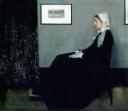
![]()
The normal or positive
version of:
James Abbott McNeill Whistler (American, 1834-1903), Arrangement in Grey and Black No. 1: Portrait of the Artist's Mother, 1871, oil on canvas, 4 feet 8 3/4 x 5 feet 3 3/4 inches, Musée d'Orsay, Paris, France. Also see aestheticism, arrangement, art for art's sake, portrait, and rectangle.
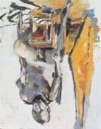
Georg Baselitz (German, 1938-), Male Nude, 1975, oil and charcoal on canvas, 78 3/4 x 63 3/4 inches (200 x 161.9 cm), North Carolina Art Museum, Raleigh. Baselitz paints subjects inverted in order to emphasize his painting's abstract qualities. He has said, "An object painted upside down is suitable for painting because it is unsuitable as an object." See Neo-Expressionism, nude, and object.
Other examples:

![]()

China,
Canton, Footed
Bowl, late 18th, early 19th century, crackle-craze underglaze, off-white
and blue, 2 1/2 x 5 3/4 inches, height of foot
1/2 inch. Of the two views of this bowl the inverted one is on the right.
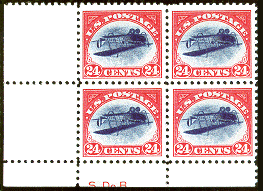
American, 24-cent "Inverted Jenny",
1918, engraving.
This is one of the most famous and highly valued of American
stamps, largely because of its rarity
as a misprint — the biplane at its center is inverted. See philately.

Umbo (Otto Umbehr) (German, 1902-1980), Mysterium der Strasse, 1928, gelatin
silver print, 29 x 23.5 cm (11 7/16 x 9 1/4 inches), Metropolitan
Museum of Art, NY. The photographer shows us both the scene he
saw when looking down from a high window, as well as the orientation
he prefers we see: his photo inverted — turned upside-down.
See photography.
|
In graphics software, to make the following change is to "invert" |
Also see chiastic, composition, figure, ground, horizontal, reverse, reversible, and vertical.
investment - A thick jacket of refractory material built around a wax model which forms the mold in lost-wax casting. It can be made of plaster or clay mixed with grog, applied in layers, with the finest and softest layers painted or gently worked over the wax model, and the outer layers reinforced with wire.
Ionic - The second of the three orders of classical Greek architecture. Ionic columns are more slender than those of the Doric order. Their dimensions are eight to nine meters high, instead of Doric's four to five. Ionic columns have a molded base beneath them. At the top of these fluted shafts, are laterality positioned volutes, beneath rectangular blocks of stone. Dentils are placed along the length of the Ionic cornice.
Images:
A schematic diagram of the Doric order and a diagram of the Ionic order.
Drawings of an Ionic capital and of an ionic column (large and small images).

Julien David LeRoy (French), Ionic Order, 1758, engraving in book, Les ruines plus
beaux des monuments de la Grace, published by H.L. Guerin
and L.F. Delatour, Paris, Plate XX, Prints and Photographs Division
Library of Congress, Washington, DC.
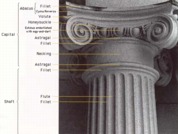
Ionic
capital and shaft, with each of its parts labeled.
Related site:
Also see abacus, architrave, capital, classical orders, composite capital and composite order, Corinthian, echinus, entablature, frieze, metope, necking, and stylobate.
IR - Abbreviation for infrared reflectography.

iridescence - A surface
displaying a lustrous rainbowlike
brightness, such as seen on
oil slicks. This effect is sometimes produced by some glass,
 glaze, and textile surfaces.
glaze, and textile surfaces.
Iridescence can also be seen in changeable colors within a range of hues, as in the feathers of some birds and the wings of some butterflies.
Opalescence includes iridescence, but upon a base of whiteness.
Examples of works incorporating iridescence:

Juan Baptiste Cuiris (Mexico, Michoacán,
Pátzcuaro), Feather Picture of the Virgin Mary, c.
1550/80, hummingbird and parrot feathers
on paper, wood;
signed, 25.4 x 24.3 cm, Kunsthistoriches
Museum, Vienna. See luminosity
and Mexican art.
Vilmos Zsolnay (Hungarian, 1828-1900), Vase, 1899, earthenware with iridescent metallic luster glaze, Minneapolis Institute of Arts. See Art Nouveau.
Also see day-glo colors, fluorescence, glitter, and ultraviolet.
![]()
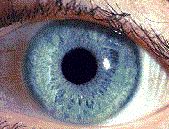
iris - Physically important in sight, a circular
band of muscles that ![]()

![]() controls
the size of the pupil. The pigmentation of the iris gives "color" to the eye. Blue
eyes have the least amount of pigment; brown eyes have the most.
controls
the size of the pupil. The pigmentation of the iris gives "color" to the eye. Blue
eyes have the least amount of pigment; brown eyes have the most.
![]()
![]()
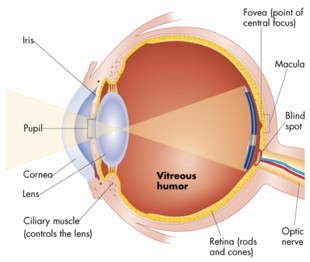
Related resources:
Another diagram of the human eye.
WildEyes is an American manufacturer of contact lenses that provide in an exotic appearance to the irises of their wearers. 
WildEyes offers lenses that change the color and texture of the wearer's irises. The company's site says, "Add some WildEyes X-Colors™ to your life. These solid extreme colors are the newest way to show you're a true sports fan with your favorite team colors. Spice up the holidays with a festive lens combo or accent your look for an extreme night out!"

![]()
WildEyes's even more daring designs change the shape along with the color and texture of the iris. These are called Jaguar, Zebra,
 Black-Out, Cat Eye, Alien, White-Out, Hypnotica, Zoomin', Icefire, Knockout,
Black-Out, Cat Eye, Alien, White-Out, Hypnotica, Zoomin', Icefire, Knockout, Wildfire, and Red Hot. They claim that, " WildEyes contact lenses give you eyes that mesmerize. If you want to stand out in a crowd, give these novelty lenses a try — even if your vision is perfect! A great complement to any Halloween costume or for any time you feel like getting a little WILD!"
Also see aqueous humor, lens, light, ophthalmology, optical, perception, photoreceptors, retina, and vitreous humor.
iris print - Also called a giclée print. A recently developed printing process using advanced technology to create a lustrous, continuous-tone digital print that meets or exceeds the quality of traditional lithography and screen printing. Organic, water-based inks in four colors are applied to the paper's surface from tiny jets one tenth the diameter of a human hair.
irony, ironic - Irony is a form of expression in which the real meaning is concealed or contradicted by the words or images used — a meaning which either markedly contrasts or is entirely opposite to that which appears to be presented. It is a trope in which there is an incongruity between what might be expected and what actually occurs. Irony involves the perception that things are not what they seem to be. The intention of one who uses irony is usually to imagine that there are two kinds of people in the audience: the first kind will not understand that what they see does not carry the ultimate meaning, and the other is aware that there is more meaning intended, and also that the first kind of person doesn't understand this. Irony is a means of expressing an attitude which is disguised by what what will seems to be obvious. The effect of irony is usually intended to be humorous, dramatic, tragic, insulting (sarcastic), or absurd. Irony is essential to satire. When irony is presented by pretending ignorance, is is the kind also called "Socratic irony." "Ironic" is the adjectival form: relating to, characterized by, using, or containing irony.
Also see ambiguity, amphibolous, coherence, incoherence, compare, counterpoint, cryptic, illusion, juxtaposition, metaphor, nuance, parody, point of view, and simile.
isocephaly - The arrangement of figures so that the heads are at the same height.
(pr. I:-so-SEF-ə-lee)
Also see hieratic.
![]()
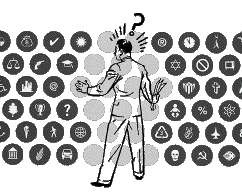
![]() issue - An issue is often a point
or matter of discussion, debate, or dispute. Some issues of great
interest in the art world may be eternal, while others come and
go from time to time. There are always issues concerning aesthetics and metaphysics. The word "issue" is often used as a general reference to problematic circumstances that draw upon the common disciplines of knowledge, such as sociology, economics, ethics, and literary criticism. In recent years, among the issues important to artists
have been conceptual art, environmentalism, feminism, gender, multiculturalism, commodification, mass media, and postmodernism.
issue - An issue is often a point
or matter of discussion, debate, or dispute. Some issues of great
interest in the art world may be eternal, while others come and
go from time to time. There are always issues concerning aesthetics and metaphysics. The word "issue" is often used as a general reference to problematic circumstances that draw upon the common disciplines of knowledge, such as sociology, economics, ethics, and literary criticism. In recent years, among the issues important to artists
have been conceptual art, environmentalism, feminism, gender, multiculturalism, commodification, mass media, and postmodernism.
Further examples of issues can be found in the contexts of articles about cultures, periods, movements, and styles.
Also see art criticism, genre, interdisciplinary, isms and -ism, meaning, quality, semiotic, subject, theme, and theory.
italic - In typography,
slanted letters. They were first produced in 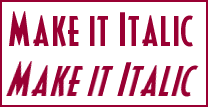 1506
by the Italian designer Aldus Manutius, who slanted letters to
give words special emphasis.
Italics now have much the same purpose: adding force to certain
words and setting off titles from surrounding text.
1506
by the Italian designer Aldus Manutius, who slanted letters to
give words special emphasis.
Italics now have much the same purpose: adding force to certain
words and setting off titles from surrounding text.
Here,
the first line of text is plain, but the second line is italic.
https://inform.quest/_art